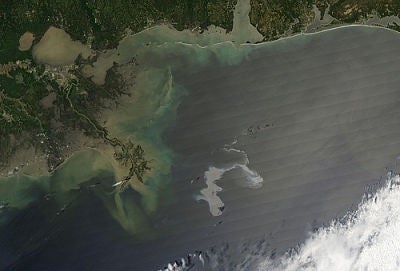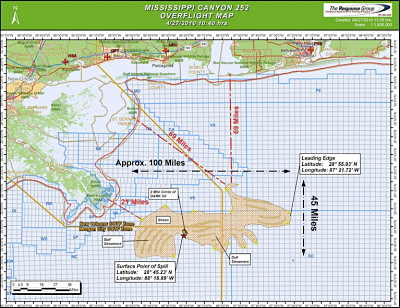
La página que intenta visitar sólo está disponible en inglés. ¡Disculpa!
The page you are about to visit is currently only available in English. Sorry!


This April 26, 2010 NASA satellite imagery shows the oil sheen leaking from the site of the Deepwater Horizon incident in the Gulf of Mexico. The sheen is approximately 600 miles in circumference and recovery. Imagery courtesy of NASA Earth
UPDATE (2pm, April 28): The Coast Guard will begin controlled burns today. Workboats will set up fire-resistant booms around segments of the slick, creating floating corrals before lighting "small, controlled burns" of several hundred gallons each that will last about an hour and will not be visible from shore, Reuters reports. AccuWeather forecasters say a shift in winds could push the spill to the Louisiana coast by this weekend.
A “controlled burn” might be the best technique for attacking the vast oil slick in the Gulf of Mexico that is now a mere 20 miles off the Louisiana coastline, officials said yesterday. The blaze could be set as early as today, if wind pushes the plume toward shore, CNN reports. The situation is dire: Cleanup efforts have mopped up 48,384 gallons of oily-water mixture, but 42,000 gallons of oil a day are seeping from a broken pipe 5,000 feet deep and experts say it could be weeks before they shut off the well. A burn poses far fewer threats to wildlife than if the oil were to reach land, according to NOAA.
Late last week, officials said there appeared to be no leak from the Deepwater Horizon, an oil rig some 50 miles off shore that caught fire, burned for days, and sank on Thursday, April 22. Eleven missing workers are presumed dead. On Saturday, officials discovered the fuel pouring out of the pipe that had been attached to the rig. BP, the company leasing the rig, is racing to cap the pipe, but so far its efforts—using remote-controlled submarines to activate an emergency shut-off called a blowout preventer—haven’t worked yet.
With short-term solutions failing, Doug Suttles, the chief operating officer for exploration and production at BP (which is paying for the cleanup), told The New York Times that the company is considering other measures:
| Mr. Suttles said that a plan to use a type of tent or dome to collect the oil was progressing and was two to four weeks from being operational. On Tuesday, the company received permits to drill a relief well, which would be started half a mile from the current well site. Crews plan to drill toward the current well and then inject it with heavy fluids and concrete to seal it. That solution is experimental at this depth, however, and is months away. |

The current location of the oil sheen produced by the Deepwater Horizon incident, as of 10:40 am on April 27.
In the meantime, with the slick nearing shore, a burn may be the best option. It doesn’t get rid of all the oil, but the waxy residue left behind can be skimmed off the surface, or it might sink.
From NOAA:
“Based on our limited experience, birds and mammals are more capable of handling the risk of a local fire and temporary smoke plume than of handling the risk posed by a spreading oil slick. Birds flying in the plume can become disoriented, and could suffer toxic effects. This risk, however, is minimal when compared to oil coating and ingestion."
The threat of oil damaging beaches and fisheries has alarmed environmentalists and businesses.
John Sackton, editor and publisher of seafood.com, an industry news website, told Voice of America that if the oil reaches Louisiana shrimp beds could have far-reaching ecological and economic consequences. “The short-term effect is that it is not possible to fish for shrimp in waters that are polluted by oil,” he said. “Theoil gets into the product and also it fouls the nets. So any place where there is visible oil, they would have to shut down fishing. The second problem is a longer-term problem as to whether there is anything that is toxic in the water that is going to impact shrimp survival.”
The spill also threatens havens for migratory birds, the Houston Chronicle reports:
| Louisiana has asked the Coast Guard to protect the Pass-a-Loutre Wildlife Management Area near the Mississippi from the spill with floating boom lines. Also east of the river, brown pelicans, royal terns and laughing gulls are among dozens of species nesting on the Breton and Chandeleur barrier islands.
If oil gets on the birds, cleanup crews will find the islands hard to reach, accessible only by boat. “It's a pristine area,” said Eugene Turner, a Louisiana State University ecologist. “I can't think of anything good that could come from this.” |
The Exxon Valdez disaster, which dumped 11 million gallons of oil into Prince William Sound, still dwarfs this spill. Experts say that at Deepwater Horizon’s current flow rate, it would take more than 260 days to rival Exxon Valdez; but if the flow isn’t stemmed, it could become one of the worst spills in US history.